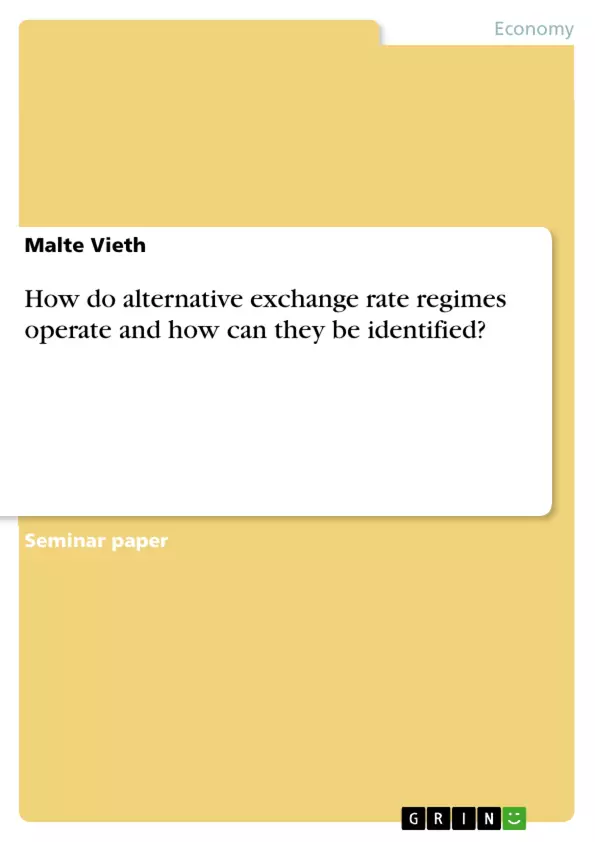The choice of the exchange rate regime is essentially for a country. According to the
impossible trinity principle a country desires a fixed exchange rate, an autonomous
monetary policy and full capital mobility simultaneously. Unfortunately only two
features at the same time can be realized. A fixed exchange rate has two major
benefits compared to a floating exchange rate. If stable it makes the trade of goods
and assets between countries easier and less costly. Additionally a fixed exchange
rate may improve monetary policy discipline as expansionary monetary policy is
less available to maintain a fixed exchange rate. This may lead to a lower inflation
rate in the long run. But the major disadvantage is that a fixed exchange rate regime
removes the possibility to use monetary policy in a flexible way to deal with
recessions (Abel, Bernanke and Croushore, 2011). Therefore many countries
choose an exchange rate regime between both extreme cases (fixed or flexible
exchange rate regime). In the second chapter I will give some important theoretical
background concerning exchange rate regimes. In particular I will explain different
types of exchange rate regimes and show the difference between ‘de jure’ and ‘de
facto’ exchange rate regimes. In the last part of the second chapter I will illustrate
the complex exchange rate regime of the European Union. In the third chapter I will
show the toolbox of a central bank to influence its exchange rate. In the last part of
the third chapter I will show briefly the different instruments using the example of
Switzerland in the recent past. In my conclusion I will try to answer the question
‘how can different exchange rate regimes being identified’.
Table of Contents
- Introduction
- Theoretical background
- Types of exchange rate regimes
- De jure vs. de facto exchange rate regimes
- Status quo European Union
- Central Bank's toolbox to manage its exchange rate
- Instruments
- Analysis for the Swiss National Bank
- Conclusion
Objectives and Key Themes
This paper examines alternative exchange rate regimes, analyzing their operations and methods of identification. It explores the trade-offs between fixed and floating exchange rate systems and investigates how countries choose between these extremes. The paper also delves into the tools available to central banks for managing exchange rates, illustrating these concepts with the example of the Swiss National Bank.
- Types of exchange rate regimes
- The difference between 'de jure' and 'de facto' exchange rate regimes
- The tools available to central banks for managing exchange rates
- The influence of the impossible trinity principle on exchange rate regime choices
- The exchange rate regime of the European Union
Chapter Summaries
- Introduction: This chapter introduces the topic of exchange rate regimes, highlighting the key trade-offs between fixed and floating exchange rates. It explains the impossible trinity principle and its implications for exchange rate regime choices. The chapter also provides a roadmap for the paper, outlining the structure and key themes.
- Theoretical Background: This chapter provides a detailed explanation of different exchange rate regimes, ranging from freely floating to fixed and adjustable pegs. It analyzes the advantages and disadvantages of each regime, emphasizing the importance of understanding these theoretical concepts for evaluating the practical applications discussed in later chapters.
Keywords
This paper focuses on key concepts including exchange rate regimes, floating and fixed exchange rates, the impossible trinity principle, 'de jure' and 'de facto' regimes, central bank intervention, and the European Union's exchange rate regime. It also explores specific examples such as the Swiss National Bank and its management of exchange rates.
- Quote paper
- Malte Vieth (Author), 2013, How do alternative exchange rate regimes operate and how can they be identified?, Munich, GRIN Verlag, https://www.grin.com/document/271201



